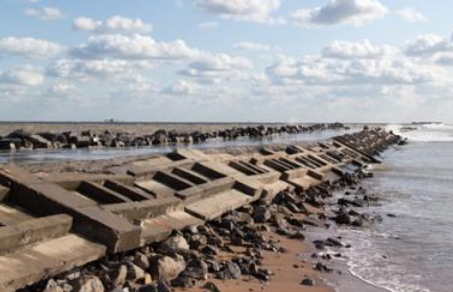(单词翻译:单击)
JUDY WOODRUFF: And now to our NewsHour Shares. Seawalls help to protect developed shorelines, but they can also destroy crucial habitat.
One project in Washington state aims to fix that. Ken Christensen of KCTS' EarthFix explains.
KEN CHRISTENSEN: The Seattle waterfront is changing right beneath your feet.
JEFF CORDELL, University of Washington: When you walk along Seattle's sidewalk, you will be walking on glass panels.
KEN CHRISTENSEN: But look deeper, and you will see that the changes aren't for tourists. They're for natives.
JEFF CORDELL: Their function is to provide light to help thousands and thousands of little baby salmon.
KEN CHRISTENSEN: It's one feature of Seattle's new seawall, a $400 million infrastructure project that's doubling as a really big science experiment, the biggest of Jeff Cordell's career.

JEFF CORDELL: Nothing has ever been tried on this scale. You're walking on foot after foot after foot of new habitat.
KEN CHRISTENSEN: Cordell wants to see if coastal cities can better coexist with fish. For 80 years, Seattle's seawall was like most, a flat, concrete slab that held back the sea, but destroyed shallow water habitat that many species thrive on.
Every spring, young salmon would migrate from Seattle's Duwamish River to the ocean, and they're hard-wired to stay close to shore, which means they run right into this.
In the inky darkness under the pier, life can get confusing for a fish.
JEFF CORDELL: There's a good example of a shadow line from a pier. And they don't want to cross the shadow line, so they just mill about here.
KEN CHRISTENSEN: The new seawall is supposed to make life easier, not only by providing a naturally lit corridor for fish to pass through on their way to the ocean, but also by featuring overhangs and rocky surfaces along the way for fish food to grow on.
JEFF CORDELL: Look at the brown scum here. We love to see that, because that's where the little crustaceans grow that the juvenile salmon feed on. You can't count out brown scum.
KEN CHRISTENSEN: Most seawalls are still get built like Seattle's was back in the 1930s. And construction is expected to increase.
JEFF CORDELL: There's going to be much more need for coastal infrastructure and a lot more thinking about how we can best create habitat for the organisms that we're removing it from.
KEN CHRISTENSEN: Once the seawall is complete, Cordell plans to begin a decade-long monitoring project to figure out if it does what it's supposed to.
JEFF CORDELL: Even that brown stuff needs a good amount of sunlight to grow.
KEN CHRISTENSEN: If the experiment succeeds, the Seattle waterfront's biggest change could be the change it inspires in seawalls around the world.
For the PBS NewsHour, I'm Ken Christensen in Seattle, Washington.


